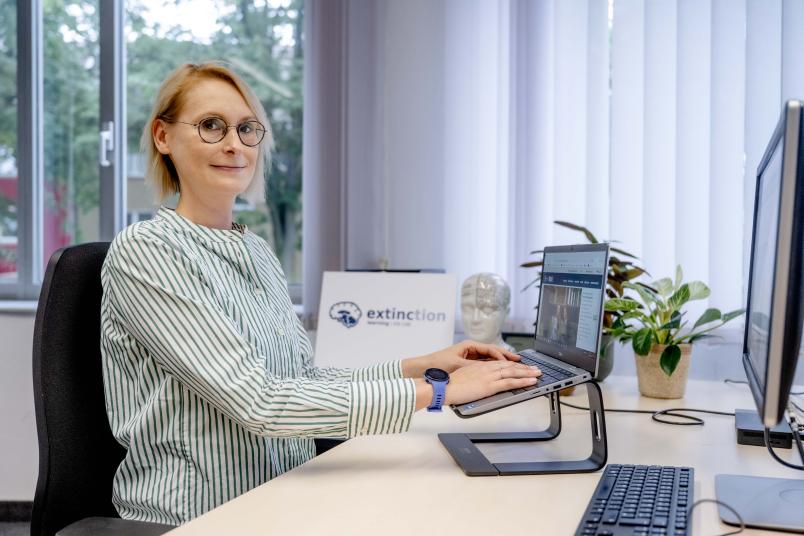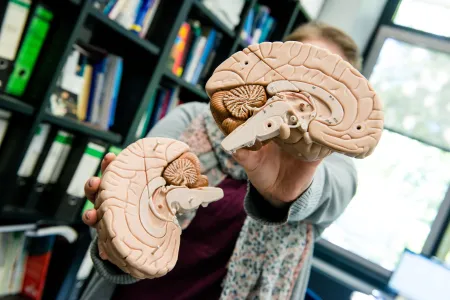
Neuroscience
Franziska Labrenz researches the communication of the gut-brain axis
She’s a member of the Extinction Network and has already completed stations at all three campuses of the University Alliance Ruhr. Franziska Labrenz researches the multiple factors that affect our pain perception.
Looking at cognitive neuroscience, what is its most fascinating aspect for you?
The fact that it affects each and every one of us: every human being thinks, dreams and remembers, acts or feels on the basis of certain motivations – and this is essentially also true in the animal kingdom. In humans, I find it particularly fascinating that tiny neurons combine to form networks and determine us. This is particularly evident when it comes to pain. At the Department of Medical Psychology, we see every day how chronic visceral pain, for example abdominal pain, can completely change a patient’s world and affect their life. Pain is associated in completely different ways across the entire range of emotions, and this is often really hard for sufferers; in other words, it’s not the pain itself that’s so bad, but rather the factors that go hand in hand with it.

The gut is the second brain of humans.
I’m doing research specifically on the gut-brain axis: the brain and the gut are closely linked – so much so that many refer to the gut as the second brain of humans. This is indeed my approach, too. The links from the gut up to the brain control our emotions, behavior and memory to a much greater degree than the pathways from the brain down to the gut, and they can cause a variety of dysfunctions.
What has been your most important research finding so far?
In our fields, this is extremely difficult and very complex, largely because of the bio-psycho-social disease model. We have the gut and the brain, i.e. biological factors, but we also have many other components that play into it: psychological and social factors, such as an individual’s pain perception and how they cope with pain on an emotional and cognitive level, plus their social environment at work and at home. Within such complexity, THE one breakthrough result does not exist. Every single result is exciting, because it slots into the big picture like a piece of a jigsaw puzzle and paves the way for new approaches to research questions.

We can provide much better help to patients today than we could 30 years ago.
Senior colleagues in our field often polemicize: 30 years of research and we haven’t advanced a single step. To some extent, people are frustrated, because the causes and development of chronic visceral pain haven’t yet been adequately understood, and the diagnosis and therapy depend to a large extent on the individual physicians. But I can also see the progress that’s been made and believe we can provide much better help for patients today than we could 30 years ago.
Specifically, we mainly study learning and memory processes by simulating pain in the gut and displaying certain symbols at the same time, so that patients learn to associate the pain with a given symbol. This is the basic model of classical conditioning. My dream would be one day to have a drug or a simple therapy that extinguishes this association, in order to improve the patient’s quality of life.
You are committed to promoting equal opportunities. What do you think constitutes good, successful equal opportunities?
Personally, I find the term “equal opportunities” rather awkward – it sounds a bit like certain quotas have to be met and someone ends up being excluded and missing out. As Equal Opportunity Representatives at Collaborative Research Centre 1280 “Extinction Learning”, we tend to focus on individual competencies and interests, asking and considering the following questions: which skills does an individual have? We give our early career researchers room to explore which path suits them best: some are very good at teaching, others prefer to work in a team, and still others are better at working on their data in private and want to fully concentrate on writing their paper. We understand equal opportunities to mean getting the maximum out of everyone and catering to individual requirements. This means, for example, that a colleague can be less involved in teaching for a certain period of time if they need to finish a publication, that we provide flexible working options, such as the option to work from home and childcare arrangements.

